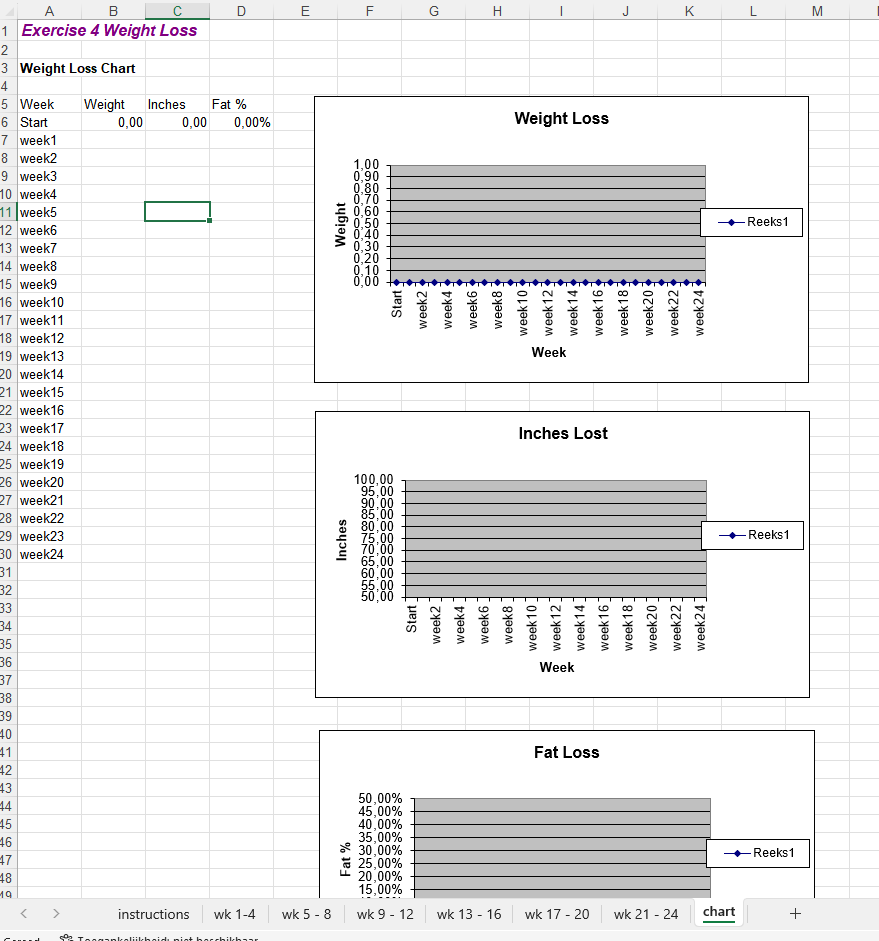weight loss chart
Sponsored Link免费模板 保存,填空,打印,三步搞定!

Download weight loss chart
微软电子表格 (.xls)免费文件转换
- 本文档已通过专业认证
- 100%可定制
- 这是一个数字下载 (116 kB)
- 语: English
Sponsored Link
How to prepare a weight loss chart? Do you need a weight loss chart?
A weight loss chart, like the one you provided, is a highly useful tool for anyone on a weight loss journey. Here are several reasons why such a chart is beneficial, along with a structured breakdown of its components:
Why is a Weight Loss Chart Useful?
1. Goal Tracking:
Visual Progress: It provides a clear visual representation of your progress over time, making it easier to see how far you've come.
Motivation: Seeing tangible results can boost your motivation to continue with your weight loss efforts.
2. Accountability:
Regular Monitoring: By regularly updating the chart, you hold yourself accountable for your weight loss goals.
Consistency: Helps maintain consistency in tracking various metrics related to weight loss.
3. Detailed Analysis:
Comprehensive Data: Tracks multiple parameters such as weight, waist, hips, upper arms, thighs, chest, total inches, and body fat percentage.
Identifying Trends: Helps in identifying trends and patterns, such as which days or weeks show more progress.
4. Health Monitoring:
Body Measurements: Provides a holistic view of changes in body composition, not just weight.
Body Fat Percentage: Tracking body fat percentage is crucial for understanding changes in muscle mass versus fat loss.
5. Adjustments and Improvements:
Informed Decisions: Helps in making informed decisions about diet, exercise, and lifestyle changes.
Immediate Feedback: Provides immediate feedback, enabling you to adjust your strategies if progress stalls.
Structure of the Weight Loss Chart
Components:
- Week #
- Weight
- % Change
- Waist
- Hips
- Upper Arms
- Thighs
- Chest
- Total Inches
- Body Fat
- % Change
- Start
Instructions to Use the Chart:
- Week and Day Columns: Fill in the week number and the specific day you are recording data.
- Weight: Enter your current weight.
- % Change: Calculate and record the percentage change in your weight from the start of the week.
- Body Measurements:
- Waist: Measure and record the circumference of your waist.
- Hips: Measure and record the circumference of your hips.
- Upper Arms: Measure and record the circumference of your upper arms.
- Thighs: Measure and record the circumference of your thighs.
- Chest: Measure and record the circumference of your chest.
- Total Inches: Sum up all the body measurements (waist, hips, upper arms, thighs, and chest) to get the total inches.
- Body Fat Percentage: Record your body fat percentage.
- % Change in Body Fat: Calculate and record the percentage change in your body fat from the start of the week.
Example Instructions:
Starting Numbers: Enter your initial weight, waist, hips, upper arms, thighs, chest, and body fat percentage in the 'Start' row.
Weekly Tracking: Record your weight and measurements once a week, ideally on the same day each week.
Daily Tracking (Optional): If you prefer, you can track your weight and measurements daily. Just ensure you also update the weekly numbers.
Charts and Visualization: Check the chart page to see your progress in weight, inches lost, and body fat percentage.
Using this chart regularly will help you maintain a structured approach to weight loss, keep you motivated, and provide insights into your progress and areas that may need adjustments.
Download this weight loss chart template now!
DISCLAIMER
Nothing on this site shall be considered legal advice and no attorney-client relationship is established.
发表评论。 如果您有任何问题或意见,请随时在下面发布
Sponsored Link

